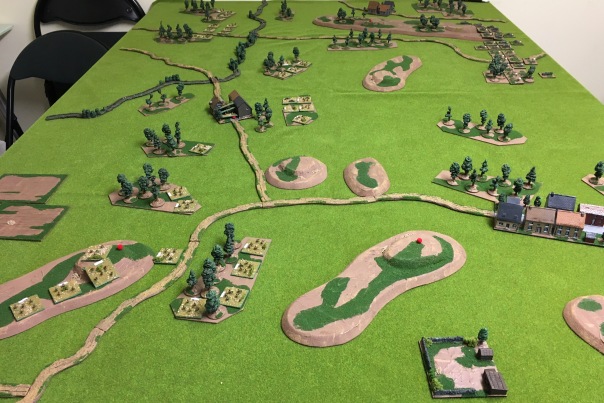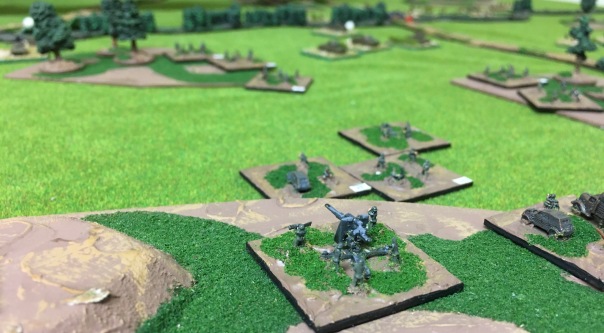Since crossing the border into the Soviet Union the 8th Panzer Division had made remarkable progress sweeping aside disorganised Soviet defenders at every turn. However, with reconnaissance reports indicating more organised defensive position astride the division’s main thrust it seemed that the Soviet resolve could be stiffening. As a result the division reconnaissance reports were analysed before the division’s advanced battalions resumed their advance.
Indications were that three enemy infantry battalions were deployed across a 7km frontage, but additional forces were available to directly support the position. Of particular interest were that two key heights were not held, one on each flank. The Soviet commander had clearly opted for a less exposed position ensuring he was less likely to be outflanked. While the position of these undefended objectives encouraged thr splitting of forces, to seize terrain, this was quickly ruled out. The assets of the division would act in close support to bring overwhelming resources to the decisive point. The advanced units committed to 8th Panzer Division attack comprised the 1st and 2nd Battalions from the 10th Panzer Regiment, with supporting panzer grenadiers, as well as 1st Battalion from the 28th Schutzen Regiment. Two 105mm and one 150mm artillery battalions were to provide support fires while a Luftwaffe Flak battery was allocated for direct support, a counter should Soviet heavy armour be encountered.
By 2pm the various battalions of the division were once again moving forward. The main effort was to be against the Soviet left flank. The 1st Panzer Battalion was to advance at speed on a narrow front first securing high ground and then advancing to secure a key bridge known to be held by Soviet infantry. The Panzers here were to be be supported by much of the artillery. To the left of 1st Panzer the 2nd Battalion of 28th Schutzen Regiment was to advance to a low ridge in the centre of the sector. This ridge provided ideal firing positions for the attached Luftwaffe Flak battery and would protect the flank of the Panzers from Soviet armour which it was expected to be in reserve. A further artillery battalion was allocated to this battalion. Finally, the 2nd Panzer Battalion was initially held back for possible exploitation. Like the 1st Panzer Battalion it contained a company of panzer grenadiers.
Above the battlefield viewed from the north with the Soviets on the left. The Germans can be seen advancing on the top right. Below, the Germans advancing. The panzer Grenadiers of 1st Panzer are in Sdkfz 251s.
1st Panzer’s advance was uneventful until it neared a bridge over a tributary of the Voditsa River. Here, a well placed Soviet ambush engaged the right flank of the 1st Panzer. The Soviet infantry, firing anti-tank rifles, caused a number of casualties on German light tanks. Almost simultaneously dark shapes were reported some 2km distance as Soviet armour was was committed to a counterattack. The Soviet infantry it seemed were supported by an Independent Tank Regiment comprised of three tank battalions reconstituted from other formations. With the Pz38ts and PzIIs of 1st Panzer Battalion clearly unable to engage the Soviet heavy tanks the battalion was ordered to retire at speed and reform for its next task in what was expected to be a battle of manouvre.
Below, a Soviet SMG company in the woods appear from ambush positions to engage the advancing armour with anti-tank rifles.
Simultaneously in the centre advancing German infantry (2/28th) had become engaged with a Soviet infantry near the low ridge it was tasked with seizing, as can be seen below.
Below, a view from the Soviet lines as the Soviet armour advances.
As the Luftwaffe Flak battery was deployed the infantry engagement reached critical levels when a reinforced Soviet company launched an attack on the German left. While the German infantry repositioned against this attack, supported by 105mm artillery fires, German infantry supported by infantry guns and HMGs engaged the main enemy defensive position. With casualties mounting the Soviet infantry, classed as green, broke in rout.
As the Soviet infantry streamed to the rear Soviet tanks arrived in the centre. Split into two parts, by woods and the tributary of Voditsa River, the T-28s advanced on the German 2/28th left while KV-1s, T-34s & T-26s the right. Now as the Soviet armour engaged the German infantry 2nd Panzer raced to the German left and to engage the Soviet T-28s. A confusing but desperate engagement now developed between Soviet armour, classed as veterans, and the German infantry. Hopelessly ineffective Pak-36s engaged KV-1s, 88 Flak engaged first T-28s, KV-1s and then T-34s with little result while German infantry engaged the advancing tanks with anti-tank rifles. However, it was German artillery that slowed the advance as all three German artillery battalions bought down heavy artillery fires that decimated the Soviet light tanks.
Visible above to the rear of the German infantry are both 1st Panzer Battalion (right) which is retiring and 2nd Panzer (left) as it moves to the left. Below, another view of the German centre.
The Soviet commander, seeking to support his armour with infantry was finally been given permission to reinforce the armoured attack. As such infantry from the Soviet left surged forward from their defensive position along the tributary of Voditsa River. This action in turn drew the return of the 1st Panzer Battalion, who now attempted to advance along their original axis. A brief but desperate action in a narrow defile halted the German advance, with heavy casualties to the attached panzer grenadiers. While this spoiling attack failed to catch the advancing Soviet infantry in the open, as was hoped, it halted their advance to support the Soviet armour.
Casualties on the German infantry had been slowly mounting and eventually the battalion broke retiring to the rear. However, no sooner had it retired the officers rallied the battalion. Almost immediately the 2/28th advanced and secured the low ridge again. Meanwhile, and still unsupported by infantry, the Soviet armour of the Independent Tank Regiment was fully engaged against against 2nd Panzer and supporting panzer grenadiers. While the KV-1s were immune to the 37mm and short barrelled 75mm guns of the German tanks the T-28s and T-26s were not. Even the PzIIs with their 20mm cannons created havoc as they swept around the the Soviet rear. While shattering the Soviet armour the 2nd Panzer secured the village of Nesterov. Victory seemed secure!
Below, 2nd Panzer Battalion advances at speed to outflank the Soviet armour.
Yet the Soviet commander was unwilling to accept defeat. The political officers having rallied the infantry of the Soviet centre now ordered several companies forward in a desperate attempt to recapture the village of Nesterov. Yet the main threat to Nesterov came from the Soviet right where, a veteran battalion, also surged forward. As 2nd Panzer reformed, after its desperate battle against Soviet armour, wave after wave of Soviet infantry attacked. Reinforcements, consisting of Panzers, were thrown into Nesterov to bolster the outnumbered panzer grenadiers that faced in excess of two companies of attacking Soviets. 1st Panzer meanwhile raced to reinforce 2nd Panzer in its third attack of the afternoon. Yet as 1st Panzer engaged the attacking Soviets the defenders of Nesterov, having repelled several assaults, were finally overcome.
After a desperate battle, and with artillery fires exhausted, the German attack was called off. The Soviets it seemed could after all fight with great determination.
The scenario was developed using the Scenario Generation System and involved a Hasty Attack by the Germans against the Soviet defences. Both players opted for an Option A reinforcement. While the Soviets outnumbering the Germans the superior German command and control allowed the Germans considerable more ability to manoeuvre. Indeed, during the engagement no less than seven German order changes were achieved. This assisted the Germans to break off, reform and manoeuvre, often attacking the Soviet flanks. This combined with the German ability to maintain combined arms greatly aided their attack. However, the Soviet resolve was determined. In this scenario when a Soviet battalion is first subjected to fire its morale is determined. One infantry battalion was determined to be green, one regular and one veteran. As the Independent Soviet Tank Regiment was also classed as classed as veteran the Soviet defence was extremely determined. A great game and an ideal outing for my son’s Soviets.







